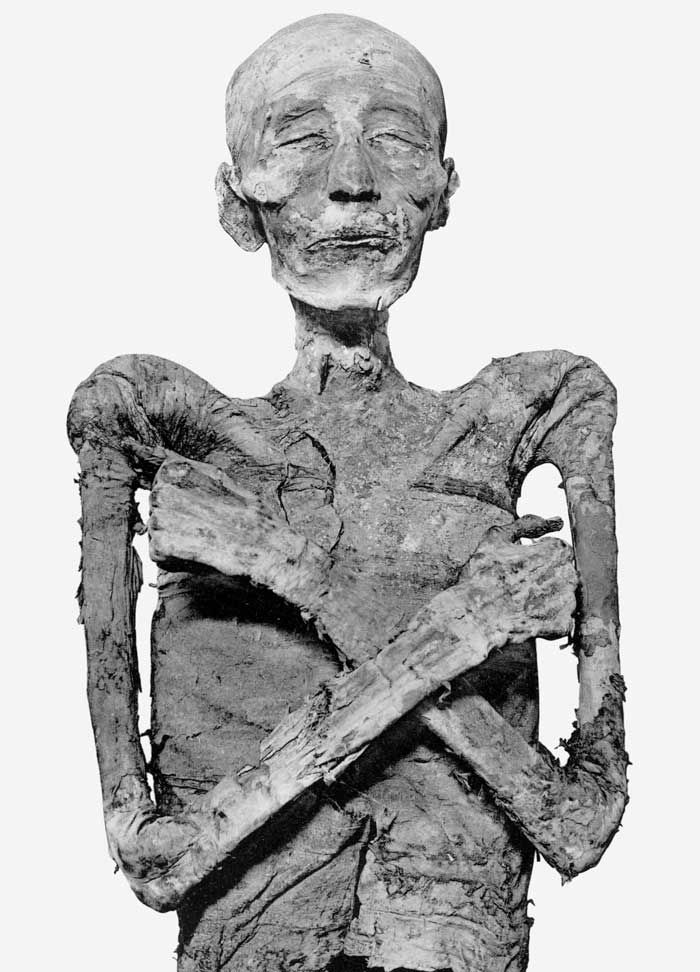Unwrapping an ancient Egyptian mummy during the early 1900s.

Human and animal mummies have been studied intensively since Napoleon’s expedition to Egypt in 1798. Public unwrappings in mid-nineteenth century America sought to answer scientific questions about the ancient remains, as well as satisfy the curiosity of paid on-lookers. Mummies now yield their secrets in less invasive ways, informing Egyptologists about diseases, life span, and ancient nutrition. As one of the ultimate symbols of ancient Egypt, the mummy continues to inhabit our own culture through many media–especially movies.
In 1894, Nancy Fish Barnum, widow of the famous circus owner, acquired this mummy in Egypt and presented it with the coffin to the Bridgeport Scientific Society and Fairfield County Historical Society. The mummy and the coffin were not originally a “set,” but rather had been put together for sale in modern times. The coffin once belonged to a man named Pa-ib (for more information see the Coffin of Pa-Ib), while the mummy is that of a woman approximately thirty years old. The mummy was unwrapped in August 1894, during which the audience remarked on the “thousands of yards of linen bandages” that were unwrapped from a body that had a “peculiar and slightly disagreeable odor.”
George Gliddon and the Great Mummy Unwrappings of 1850 and 1851
On December 14, 1824, the first public unwrapping of a mummy in America was performed before a small audience of medical and scientific gentlemen at New York City’s Castle Garden. The mummy which was unwrapped had been brought by Captain Larkin Thorndike Lee, and its disrobing was engineered in order to satisfy scientific curiosity as well as to ascertain the authenticity of the artifact. The mummy was pronounced to be genuine and female. and a description of it was given in the newspaper accounts of the unwrapping.

The next unwrapping of note was held at Rubens Peale’s New York museum in 1826. Two mummies which Peale had recently purchased were to be unwrapped before the public (although no children would be admitted, perhaps expecting the subject to be too unsettling for young minds.) on the afternoon of March 3. After this, the mummies would lie in state at the museum for the satisfaction of the curious. Mummies were a prime draw for the public—wherever they were exhibited, people came by the hundreds to view the ancient relics. Almost always, the mummies were advertised as being royal, female, and even on occasion as the princess who saved Moses from the bulrushes.

A few other unwrappings followed this one, but none were as memorable as those performed by George Gliddon in 1850 and 1851. George Robbins Gliddon was born in Devonshire, England in 1809, the son of John G. Gliddon, who later became U.S. Consul at Alexandria. He was taken to Egypt at an early age, and later even became U.S. Vice-Consul staioned in Egypt at Cairo himself. In 1842, Gliddon came to America, where he lectured on Egyptian archaeology in Boston and in Lowell, Massachusetts, and as far west as St. Louis. He also published several works about ancient Egypt: Otia Aegyptiaca, An Appeal To the Antiquaries of Europe On the Destruction of the Monuments of Egypt, and Ancient Egypt, Her Monuments, Hieroglyphics, History and Archaeology, and Other Subjects Connected with Hieroglyphical Literature.

Both Gliddon and his father had been active in procuring mummy skulls for Samuel George Morton, who was collecting the grisly reremains to bolster his theories on polygenesis—the idea that the races of man had sprung from different progenitors. One of the key arguments was that different races had different brain capacities, hence his great interest in skulls. The idea was highly racially charged and an unacknowledged goal of these mummy unwrappings was to prove that the Egyptians were not of “the black race.” The dark hue of the bodies was always explained to be the result of embalming techniques, and mention was always made of the delicate features and light-colored hair, whose consistency was described as smooth, not “crinkly” or “wooly”. Gliddon himself was a sincere follower of Morton’s theses; together with Josiah Nott, he would later publish his own version of these studies in Types of Mankind, Or, Ethnological Researches Based Upon the Ancient Monuments, Paintings, Sculptures, and Crania of Races; And Upon Their Natural, Geographical, Philological and Biblical History. This book was considered to be so hugely derogatory in regards to the black component of humanity, that it is still castigated as being virulently racist.
While in England in 1849, Gliddon purchased the Panorama of the Nile, a “transparent” moving painting of the entire great river and its attractions and brought it to America for exhibition. In order to drum uo interest in this great moving depiction of Egypt and its monuments, Gliddon also proposed to unwrap some mummies that he had obtained with great difficulty and expense. According to notes on the broadsides issued to advertise these unwrappings, In 1845 Gliddon had requested some mummies to illustrates his leactures from his friend A.C. Harris in Cairo. Harris obtained one, noted on the broadside for the exibition of those mummies “admirable mummy . . . in perfect condition,” along with a dozen other human mummies collected at Thebes, Abydos, and Memphis. In 1846, after fruitless efforts to ship them, four were sequestered at the Alexandrian Custom-house, as Mohammed Ali, the Pasha of Egypt had forbidden the exportation of antiquities by anyone but agents of European powers since 1835. An official application made by the United States Consul to the Viceroy failed, and in 1849 the four mummies were found to have succumbed to the damp of the Custom-house and were destroyed. Happily, Mr. Harris had preserved the most valuable specimens at his own residence, and was able to send them to Gliddon after a series of protracted negotiations with both the Egyptian and United States governments.
By May of 1850 Gliddon was in Boston, drumming up interest for his lectures, the Panorama, and the unwrapping of one of the mummies. The subject of the lectures was described as the “body of the daughter of a high priest of Thebes who lived more than 3,000 years ago, or about the time of Moses. It is one of the most valued specimens of the curious art of embalming, and its market value is said to be about $1,500.” Gliddon’s plan was to secure three hundred subscribers at five dollars each, which would entitle the subscriber to four tickets of admission to each of the three lectures to be given in connection with the opening of the mummy, which would be held at Tremont Temple. Gliddon had no trouble securing subscribers to the lecture series—Bostonians were anxious to get a first-hand look at one of the relics and the tickets sold out quickly. It took little time for the “daughter of a priest” to morph into a “priestess” or even a “princess” in the minds of the people. The mummy even inspired at least one unnamed poet to pen a lengthy ode, “The Mummy at Home,” in which he described the life of the beautiful young maiden and the sorrows of her broken-hearted, stalwart lover as he “weeps upon the broken stem of the lily of the Nile.”
The audience was primed for the exhibition, and over the three days of the lectures, more and more of the mummy was revealed, until on the third and final day, the mummy was proven to be no female at all, but a male “exhibiting in its fossil state the erected unequivocal mark of its sex.” Gliddon was mortified, and tried to explain the error as the result of a mistake by the undertakers. The newspapers pounced on the gaffe with glee, repeating the tale across the country. The incident inspired more poems, including a long and rambling tongue twister published in the July 9, 1850 Wisconsin Express:
“Gliddon had an explanation
Nearly ready for narration . . .
‘Gentlemen and ladies,’ said he,
‘This had surely been a lady,
But the blundering undertakers,
Or the blundering coffin makers
In the Theban shops of mummies,
Proved themselves a set of dummies,
And misplac’d the lady’s body
By this base-born, male tom-noddy.’
Great applause this statement greeted
From the ‘folks’ around him seated;
‘Twas a genuine Boston notion,
Thus to settle the commotion.
All abused’d the mummy bakers,
Stupid Theban undertakers,
For their blundering egregious
And their treatment sacrilegious
Of the holy priestess’ ashes,
And for sending them such trash as
This male mummy, with the label
Of a lady, on the table.”
There were even jokes made at Gliddon’s expense, one of which ran, “The Boston Post says that one of Mr. Gliddon’s patrons declares that although the mummy turned out to be man, he still considered it to be a dam-sel.”
Gliddon tried to diffuse the turmoil by explaining that the error had been his in incorrectly deciphering the hieroglyphics on the coffin, but the incident just would not die. He left Boston under a bit of a cloud and headed for Philadelphia, where he again advertised mummy unwrappings as a draw for his Panorama. Gliddon unwrapped two mummies in Philadelphia, another woman who was found to be as advertised, and a young child. These unwrappings went more smoothly—at least there were no surprises. From Philadelphia, Gliddon took his show to New Orleans, where he unwrapped his final mummy which he presented to the medical college which later became Tulane University.. This anonymous mummy was given the name “Nefer Atethu,” or, “Beautiful youth” many years later, during a radiological study of her and Got-Thoti-Ankh (the mummy unwrapped in Boston, who had also been given to the museum in 1858 by Josiah C. Nott. In Types of Mankind, Got-Thothi-Ankh was described as the perfect example of an ancient Egyptian as described in the books of Exodus and Ezekiel. In other words, not of “the black race.”
These two mummies and their coffins were stored in various locations, including a space under the bleachers in the football stadium. They attended three Super Bowl games and numerous college football games before being rescued and placed in a more appropriate setting at the college in the mid-1970s. According to Samuel Morton’s catalogue of skulls, the head of Got-mut-as-Ankh (the mummy unwrapped in Philadelphia) was given to him for his collection. It is not known what happened to the rest of the body, nor to the child’s mummy unwrapped in Philadelphia.
Related Post
A shocking documentary proves that mermaids do exist
SHOCKING Revelation: Thuya, Mother of Queen Tiye, Was the Grandmother of Akhenaten and Tutankhamun—What Ancient Egyptian Secrets Did She Leave Behind?
Breaking News: Astonishing Discoveries at Karahan Tepe Confirm an Extraterrestrial Civilization is Hiding on Earth, and NO ONE Knows!
Breaking News: Researchers FINALLY Discover U.S. Navy Flight 19 After 75 Years Lost in the Bermuda Triangle!
NASA’s Secret Investigation: Uncovering the Astonishing Mystery of the UFO Crash on the Mountain!
Explosive UFO Docs LEAKED: Startling Proof That Aliens Ruled Ancient Egypt!